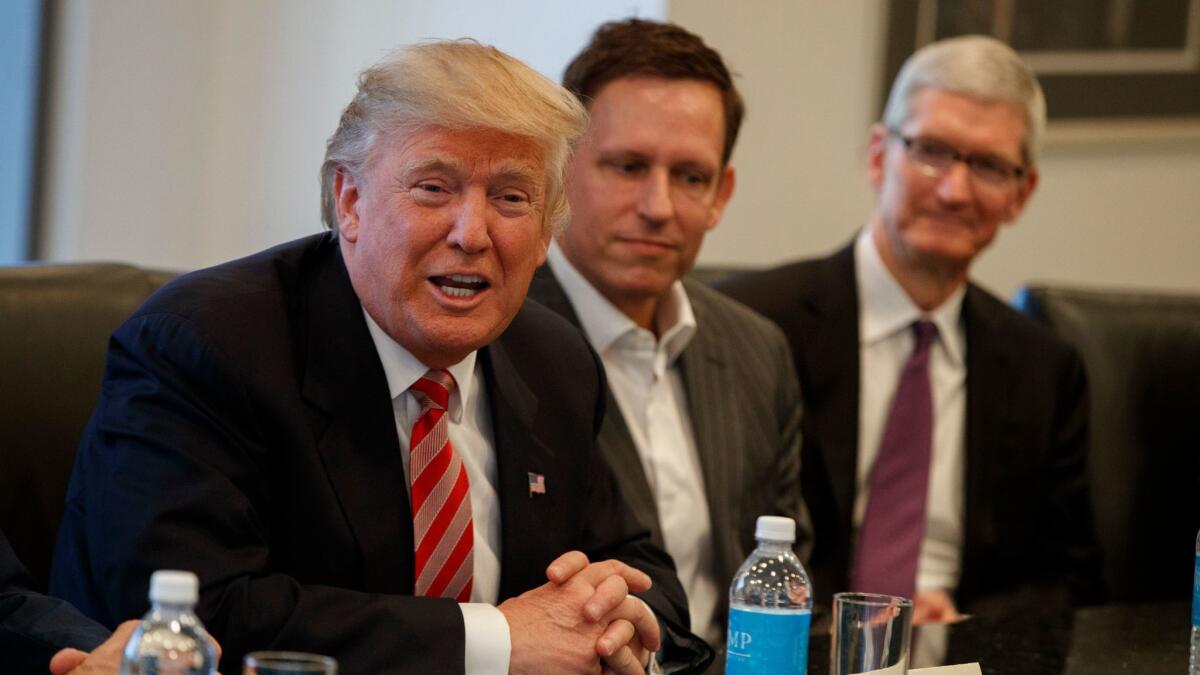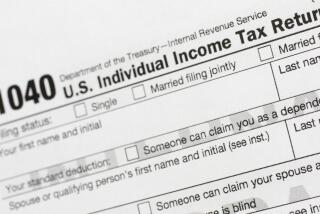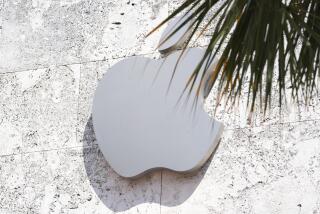Column: Apple’s bogus claim that the tax cut is making it spend more in the U.S. is just a PR sop to Trump

To hear the White House tell it, Apple’s big announcement last week that it would increase jobs and make billions in new investments in the United States is proof positive that the big tax cut President Trump signed in December is working.
“I promised that my policies would allow companies like Apple to bring massive amounts of money back to the United States,” President Trump tweeted. “Great to see Apple follow through as a result of TAX CUTS. Huge win for American workers and the USA!”
Well, no.
Apple is paying a record tax because for the last two decades, it has been the world champion at global tax avoidance.
— USC tax expert Edward Kleinbard
If anything, Apple’s announcement proves just the opposite. It underscores Apple’s success at having gamed the U.S. tax system for more than a decade before finally browbeating Republicans in Congress to do its bidding. The announcement bristles with exaggerations and misrepresentations about what the company really is promising. It glosses over the fact that the billions in overseas earnings it’s “bringing home” as a result of the tax legislation were pretty much here all the time.
Then there’s the $2,500 bonus Apple says it’s granting its employees, which parallels $1,000 bonuses announced by other companies, typically with references to their lower taxes.
“The idea that the tax bill is doing anything right now with respect to workers’ pay is inconceivable,” says economist Justin Wolfers of the University of Michigan. “At any given point in time there are literally thousands of corporations that give their workers bonuses. They do it because labor market conditions change, because they’re good people, because they’re forced to because of union contracts. It’s clear that the new corporate playbook is to never do that without tipping your hat to the White House.”
Let’s read between the lines of Apple’s statement to see just how bogus its claim — and Trump’s claim — are.
The money we’re talking about is more than $252 billion in overseas earnings ostensibly parked overseas to avoid U.S. taxes. We can start with the notion that Apple is bringing this money “back to the United States,” as Trump would have it. This is almost certainly untrue in several respects. For one thing, the asset is probably in accounts in U.S. banks or other financial institutions already. Much of it has been invested through the purchase of corporate or government bonds, which means it’s already working for the benefit of the companies it’s been lent to or the federal government.
“This idea that there’s a big bathtub of money doing no work and if we just let it work things will be better is nonsense,” Wolfers says.
It’s also clear that Apple has been putting some of this money to its own use within the U.S. over the years — it’s been borrowing against the overseas hoard to the tune of $97 billion. That’s the total of Apple’s long-term debt, as of Sept. 30, 2017.
Apple doesn’t need to borrow to fund its operations — it generated $63.6 billion in cash by selling merchandise and services last year alone. It borrows to fund its dividends and share buybacks, as a way to return some of its overseas cash to shareholders. As veteran Apple-watcher Horace Dediu observes, the company borrows to do this because if it simply paid U.S. shareholders out of its foreign cash, it would have had to fork over as much as 35% of the sum in U.S. taxes.
The shareholders, Dediu writes, “would probably complain and blame the managers for being incompetent. Such blame usually comes with a lawsuit attached.” Borrowing, by the way, gives Apple a tax break, since interest on the debt is tax-deductible.
“Effectively, they’ve repatriated $97 billion,” notes tax expert Edward Kleinbard of USC, perhaps the nation’s foremost expert in the “stateless income” held overseas by U.S. corporations. (He estimates the sum at about $3 trillion, of which about $1.2 trillion is in cash and the rest in real investment such as in bricks and mortar.) The tax legislation subjects that income to U.S. tax, though at a rate of only 15.5% on the cash and about 8% for the real investment, compared with the overall top corporate rate of 21% — that’s what’s really meant by “bringing it home.”
Apple wants to be congratulated for having to make a payment of $38 billion in this repatriation tax, which it says is probably “the largest of its kind ever made.” Kleinbard says the company shouldn’t win plaudits for this payment. “Apple is paying a record tax because for the last two decades, it has been the world champion at global tax avoidance. They’ve accumulated vast earnings outside the United States and paid tax essentially nowhere on that income to speak of.”
The size of the levy demonstrates that the earnings have not been taxed by foreign countries, or Apple would be able to credit its foreign taxes against the U.S. levy. “The $38 billion is not a sign of corporate virtue,” Kleinbard says, “but its having been the world’s biggest tax scofflaw.”
We’ve reported on Apple’s scandalous tax gaming before. Among other things, the company saved billions by exploiting the cracks between Ireland and U.S. tax laws, vesting a healthy portion of its intellectual property rights in an Ireland-based affiliate, Apple Operations Inc., which claimed to account for 30% of the company’s total net profits.
But signs were mounting that these maneuvers were losing their charm for international tax authorities. Last year, for example, the European Commission forced Ireland to start collecting more than $15 billion in back taxes on which the EC said Ireland had wrongly given Apple a pass.
The bottom line is that Apple gambled that it could wait out the U.S. government by keeping its cash overseas until a tax amnesty came about. For years, Apple CEO Tim Cook maintained that the only thing keeping the company from deploying its enormous bankroll in the U.S. was the corporate tax. Republicans in Congress finally blinked.
But Apple’s implication that it’s using its cash hoard, newly brought home, to hire more people and invest more in its operations also needs to be closely scrutinized. It doesn’t hold water.
Consider its claim that it will “create over 20,000 new jobs.” The wording is important: “Creating” jobs isn’t the same as hiring people. The indications are that Apple is using, well, “creative” math to come up with this figure. Its direct U.S. workforce today, the company says, is 84,000 persons. But it adds that figure to 450,000 jobs it says are created through “the total amount Apple spent on goods and services in the U.S.,” a figure reached by applying a conventional multiplier function to its spending. Then it throws in an additional 1.5 million jobs it attributes to the “App Store ecosystem,” which obviously is a flexible figure, and Presto! The company claims credit for 2 million jobs.
How many of these 20,000 jobs are as nebulous as those other 2 million? The company doesn’t say. But if it were hiring 20,000 individuals rather than “creating” jobs for them, the betting here is that it would say so.
The same goes for its pledge to “invest over $30 billion in capital expenditures in the U.S. over the next five years.” Again, the company implies this is a product of the tax bill, without explicitly saying so. But as Kleinbard observes, Apple already has been reporting an average $12 billion a year in capital expenditures worldwide.
The company doesn’t break out its U.S. spending versus global investment. Its statement indicates that at least $10 billion will be new capital spending in the U.S., but is murky about how much of the total $30 billion is new.
In any event, much of that spending — maybe all — is the product of the company’s existing investment needs, not its tax break. Apple says it will be investing in “data centers across the U.S.” to go with the facilities it already has built in at least five states. As it happens, one center it mentioned in its announcement last week is in Reno, which was originally announced last May, long before the tax cut bill even was a gleam in Republicans’ eyes.
Apple plainly needs more data centers because its business generates ever more data. Would it be building them with or without the federal tax break? Of course it would. Is it pocketing a big bounty from the tax cut? You bet it. Is this a “huge win for American workers and the USA,” as Trump says? That’s not clear at all.
Keep up to date with Michael Hiltzik. Follow @hiltzikm on Twitter, see his Facebook page, or email michael.hiltzik@latimes.com.
Return to Michael Hiltzik’s blog.







